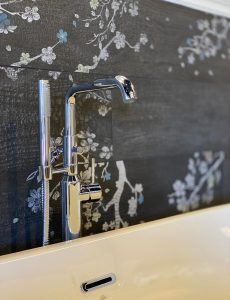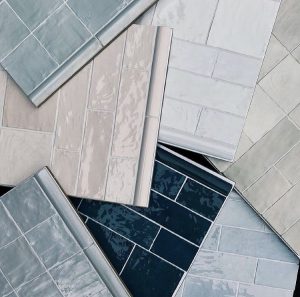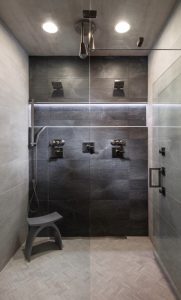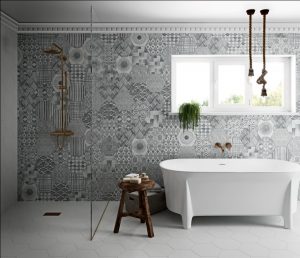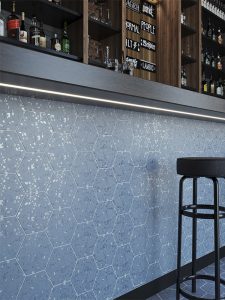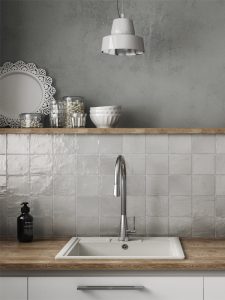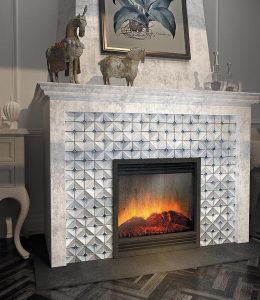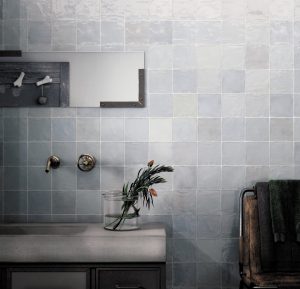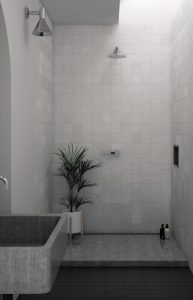Porcelain Tiles and Ceramic Tiles: What’s The Difference?
By now, we’re sure that you know in the world of tile there are many different styles that exist. However, there are two styles that often get confused; porcelain tiles and ceramic tiles. These two beautiful types have inherent differences that are important to know when selecting one for your project. Today we’re going to guide you through all things porcelain and ceramic so you can leave knowing which is right for you.
What we’ll be covering:
- How porcelain tiles are made
- How ceramic tiles are made
- Pros and cons of porcelain tiles
- Pros and cons of ceramic tiles
- Applications of porcelain tiles
- Applications of ceramic tiles
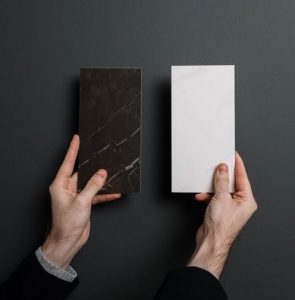
Let’s first start with the basics.
Porcelain tiles and ceramic tiles have a similar look at first glance, which is why they are hard to spot to an unknowing eye. Both of these tiles fall under the umbrella of clay-based tiles and porcelain happens to be a type of ceramic. Yet, that’s where the commonalities stop. Porcelain and ceramic tiles, aside from the material used and category shared, are made by very different processes resulting in major contrasts.
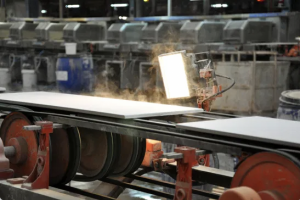
Image source: Life of an Architect
How Porcelain Tiles Are Made
You’re probably wondering what the process looks like for porcelain or ceramic tiles in this case. Great. Let us tell you.
Porcelain tiles are made from clay, sand, water and other natural materials. After the tiles are pressed into shape, dried and either glazed/screen printed, they get kiln-fired. Porcelain tiles are known as “high-fire” materials for this reason since they take scorching temperatures to bake them to perfection. The temperature these tiles are baked at is 2,500°F! As a result of this process, porcelain tiles are non-porous and extremely durable.
How Ceramic Tiles Are Made
So, what about ceramic tiles?
Ceramic tiles are made from a clay base (like porcelain) but only have water and natural minerals added to the mix. After being mixed, the tiles are shaped by pressing or extrusion, followed by drying. Once dried, the ceramic tiles are baked at 1,800°F. This lower temperature is where the key difference between ceramic and porcelain tile comes into play; The ceramic tiles are less durable, and more porous as a result.
Pros and Cons of Porcelain Tiles
Now that you know the process by which porcelain tiles and ceramic tiles are made, it’s time to review the pros and cons of each. To start, we’ll go over the pros and cons of porcelain tiles.
Pros of porcelain tiles:
- Low Maintenance: When it comes to upkeep, porcelain tiles shine the most. Thanks to their durable bodies, they don’t require additional sealing, like natural stone tiles, for example. All that’s needed to make sure that porcelain tiles last a long time is a weekly cleaning with a gentle soap, water and sponge. That’s it!
- Waterproof: As mentioned earlier, porcelain tiles are non-porous, this makes them almost completely waterproof. Porcelain tiles are dense and tough, so the chance that water will seep through is very low. This makes porcelain tiles perfect for outdoor applications. You can use porcelain tiles on patios, in pools, and building facades. They can withstand the elements, giving you a lasting design with a “wow” factor for years to come!
- High Durability: The beauty of porcelain tiles lie in their tough facades. They are perfectly capable for myriad applications; from commercial to residential and from walls to floors. This is also exactly what makes porcelain tiles so good for interior and exterior applications. With varying PEI (Porcelain Enamel Institute) ratings, there are options for high traffic areas that ceramic tiles simply can’t compete with. So you can use them on outdoor patios and pool decks worry-free as well as hotel lobbies where they’ll withstand rolling luggage.
- Myriad Design Options: With the advancements of modern technology, there are so many styles of tile available. Gone are the days of simply choosing a solid color, now you can have almost any tile you can imagine thanks to surface printing!
- Wear and Tear Less Evident: One of the other pros about porcelain tile is that it has through-body options, which means that if the surface is scratched, the color of the tile remains throughout. This, in turn, makes it easier on the eyes as years pass.
Cons of porcelain tiles:
- Higher Cost Than Ceramic Tiles: Due to the nature of creation, porcelain tiles trend towards the more expensive side. These tiles can be a few dollars more per square foot than ceramic tiles; however, since they last for years, the investment balances out over time.
- Grout: While porcelain tiles are very durable, grout is not. It should be maintained regularly and replaced every 12-15 years to ensure that the porcelain tiles don’t become damaged as it wears down.
- Installation Difficulties (i.e; cutting): The final con for porcelain tiles comes down to installation. We always suggest consulting a professional to get the best results. While this can raise the cost, the long-term impact is worth it.
Pros and Cons of Ceramic Tiles
We’d be biased if we didn’t follow up the pros and cons of porcelain tiles with the pros and cons of ceramic tiles, right? Below we go over each of this tile type.
Pros of ceramic tiles:
- Easy Installation: Unlike porcelain tiles, ceramic tiles are pretty light-weight and easy to install. With the right tools, like tile clippers, and a YouTube tutorial video, creating a beautiful backsplash design is simple.
- More Affordable: Ceramic tiles tend to be less costly than porcelain tiles since their development is less advanced. This allows you to save money for other areas of a design like mosaic feature walls, cabinetry or decor.
- Allergen Friendly: For those that suffer from severe allergies, ceramic tiles are your best bet. Since they don’t hold on to hair, dust or dirt, it makes cleaning up easy and the risk of these things hanging around impossible.
- Myriad Design Options: Like porcelain tiles, ceramic tiles also have a large variety of designs. The best part is that ceramic tiles have a handmade look, and a medley of color choices to add a unique touch to any design.
Cons of ceramic tiles:
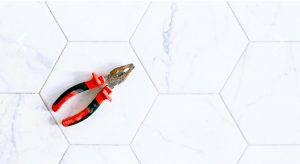
- Less Durable Than Porcelain: Ceramic tiles aren’t as durable as porcelain tiles. They’re not recommended for heavy traffic areas, like commercial floors or shower pans, and would be best suited for backsplashes as well as accent walls to avoid a tile disappointment.
- Not Waterproof; High Absorption Rate: Ceramic tiles have higher absorption rate, which makes them easier to stain. Plus, they can retain moisture if used in submerged areas.
- Wear and Tear More Evident: As mentioned above, wear and tear isn’t ceramic tile’s strong suit since the glazes used on the surface of the tile can crack or chip. As a result, the body of the tile will show through and unlike porcelain tiles, they aren’t through-body, so it’s more noticeable.
Applications of Porcelain Tile
Let’s first go through the different applications for porcelain tiles and our recommendations of Mir Collection tiles for each.
Porcelain Tiles For Showers
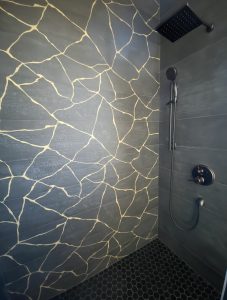
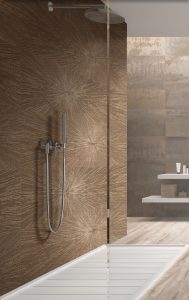
Shown Above: Kasai Notte Kintsu Porcelain Tile | Stellar Deco Copper Porcelain Tile in Shower
With their resilient bodies, porcelain tiles are a match for shower walls and floors. Thanks to their impervious nature, there’s little risk that they will stain or have water damage. A definite perk for this area of the home or commercial space.
Shown Above: Stellar Deco Steel on walls & Stellar White herringbone mosaic on shower floor
As you can see above, the pure variety of porcelain tiles create a stunning design. The dark gray porcelain color of the Stellar Deco Steel tile on the walls of this shower catches the eye instantly. Then, the contrasting Stellar white herringbone porcelain tile lightens the mood with its ethereal body. With a glittering body, these two porcelain tiles instantly create a design worth swooning over.
Porcelain Tiles For Living Room Floors
Shown Above: Kasai Notte Porcelain Tile on Living Room Floor
Nothing beats the beauty of porcelain tiles in a living room, especially one that has pets or kids running around. Their high durability ensures that the daily movement of your furry friends, children, and furniture won’t impact the aesthetics of your home. The best part about porcelain tiles, as mentioned above, is that they won’t show scratches easily. So say goodbye to worrying about floor damage and hello to everlasting, durable style.
Shown here, our Kasai Notte makes a particularly great option for living room floors. It’s a twist on traditional wood flooring and with its darker tone, it creates a sense of depth. Perfect for interiors that want a bold statement while remaining classically appealing.
Porcelain Tiles For Bathroom Walls and Floors
Shown Above: Movement Porcelain Tile Collection in bathroom
Ah, the beauty of using porcelain tiles in the bathroom is endless. You can mix and match a variety of patterns and styles to achieve a truly unique look. Plus, thanks to their waterproof bodies, you don’t have to worry about water damage after every soak or shower. You just have to make sure to clean weekly to keep them sparkling!
As seen above, our Movement Collection makes a great option for bathrooms. With patterned and plain hexagonal options available, these porcelain tiles add a lovely twist to your overall look.
Porcelain Tiles For Bars and Restaurants
Shown Above: Terra Speckled Blue Terrazzo Look porcelain tile in a bar
A perfect way to showcase the beauty of porcelain tiles is along the walls of a bar or as a bar backsplash. Since porcelain tile makes a more durable option, it’s a great way to add a gorgeous statement in a commercial space without the worry of staining or scratching.
One of our favorites porcelain tiles for a commercial bar or reception area? The Terra Blue Speckled tile. This amazing terrazzo look hexagon porcelain tile is like confetti for your design. Adding a splash of undeniably fun color and giving off a contemporary cool feeling.
Porcelain Tiles For Commercial Flooring
Shown Above: Imperial Carrara look porcelain collection in restaurant
It’s with little surprise that due to their durability, porcelain tiles make an excellent choice for commercial flooring. With higher PEI ratings, they can handle the daily wear and tear of guests coming in and out of their seats. This is perfect for restaurants, bars, and hotels that seek minimal upkeep and longevity for their materials.
The best part about porcelain is that you can still get the coveted, upscale look in commercial areas that a stone tile would bring. As seen above, our Imperial Collection brings the beauty of natural stone to a space without the maintenance.
Porcelain Tiles for Patios and Outdoors
Shown Above: Tanglewood Porcelain Tile Mix on residential patio | Tanglewood Aqua porcelain tile on commercial deck
The great outdoors are another perfect example of where porcelain tile can be used. Thanks to the high temperatures used during manufacturing, porcelain tiles are non-porous, strong and dense. This makes them ideal for many climate types and nearly every type of outdoor application. We always recommend using a matte finish or a textured body to add some more traction underfoot for the porcelain tiles on patios, pool surrounds, or pool decks. Plus, porcelain tiles are frostproof, which means there’s no chance that they’ll absorb the water, expand and eventually crack. A win-win for longevity and style, if you ask us.
Now, let’s go through the different applications for ceramic tiles and our recommendations of Mir Collection tiles for each.
Applications of Ceramic Tiles
Ceramic Tiles For Kitchen Backsplashes
The wonder of ceramic tiles for kitchen backsplashes lies in their ability to create a handmade look. With their glazed or unglazed bodies, they add a special touch to any design. Since these tiles are known for their hypoallergenic benefits, they won’t hold dirt or dust if cleaned regularly. This is a plus for the kitchen area where that’s the last thing you want lingering about!
Our shimmering Silk Gure tile is a perfect option for a kitchen backsplash. This 4” square ceramic tile has a wavy texture and exquisite glossy finish. It reflects sunlight, and creates a sparkling diamond effect as a result.
Ceramic Tiles For Fireplaces
Bring the heat with ceramic tiles! These tiles work well on the facade of a fireplace. Thanks to their natural beauty and unique design embellishments, they are perfect for adding a splash here. Plus, they’re durable enough to handle the high temperatures without fading or showing damage.
We love the way our Blue Pillow tile works on a fireplace. It gives a hint of style without overpowering the rest of the design. With prevalent movement and a unique geometric shape, it can create a covetable focal point in any residential or commercial space!
Ceramic Tiles for Bathroom Walls
Shown Above: Satin Blanc Ceramic Tile + Satin Lavanda Ceramic Tile in Bathroom
While it’s not advisable to use ceramic tiles on a shower floor, you can still enjoy the beauty of these tiles in your bathroom. Placing the ceramic tiles on shower walls or bathroom backsplashes is a great way to add a natural touch to the space.
Using square ceramic tiles, you’ll instantly add an old world twist to any design. These handmade ceramic tiles have a beautiful glaze that dazzles the eyes. With pastel hues on their glazed ceramic tile bodies, it’s the perfect touch for those who crave a subtle statement piece.
There you have it; the various differences between porcelain tiles and ceramic tiles. Now, you’re equipped with how to use them to give you the best design project outcome! Want to explore all our porcelain and ceramic tiles? Shop them here.


